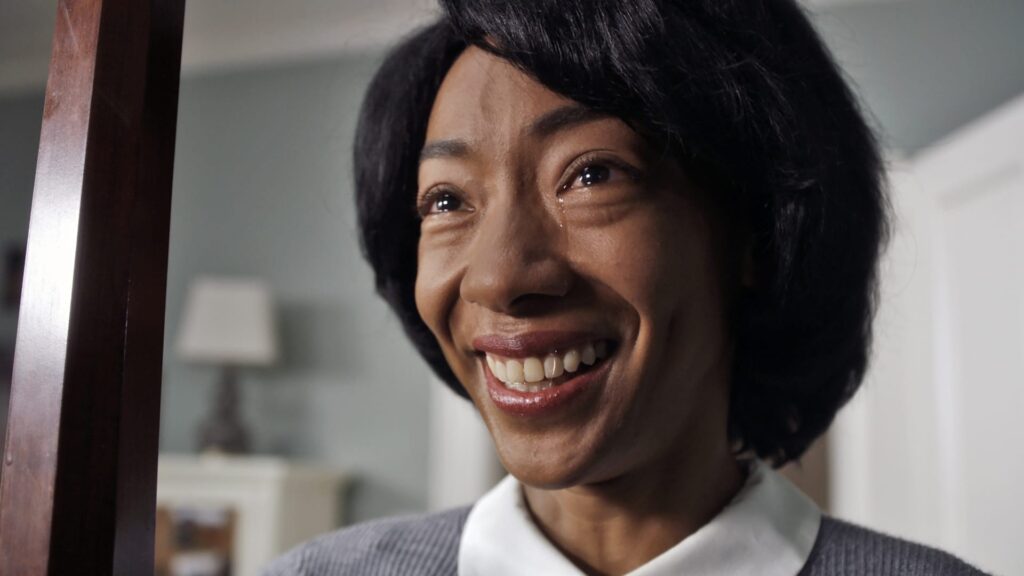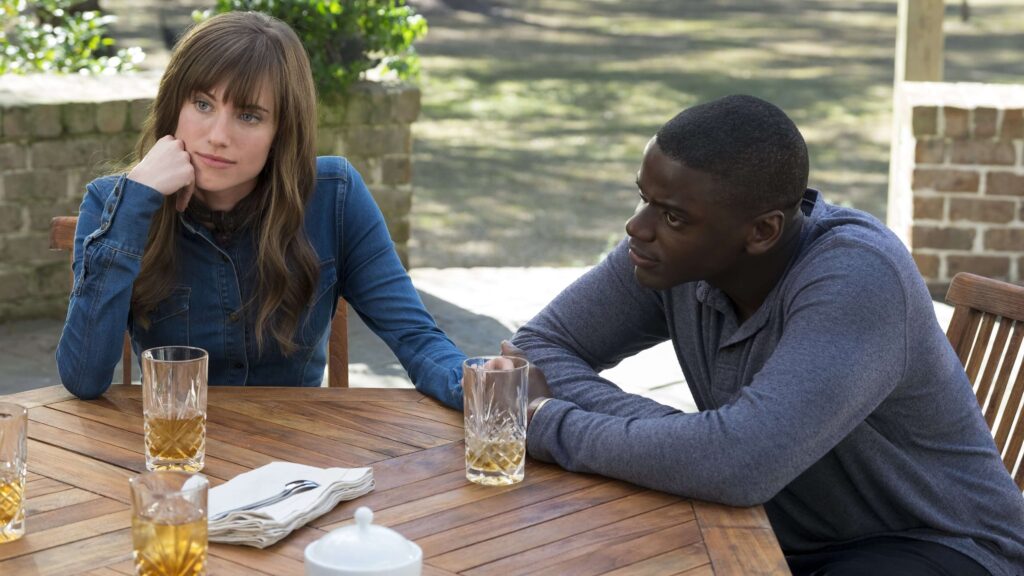Get Out

R, 2017, Horror/Comedy, 1h 44m
Table of Contents
What Is Get Out About?
A young African-American man travels for a weekend getaway with his white girlfriend to meet her parents.
Why You Should Watch Get Out
One of the most prominent themes of Get Out is the modern reimagining of slavery. The Armitage family’s operation, which involves abducting black individuals and using their bodies for the benefit of white people, echoes the historical chattel slavery but with a sinister, science fiction twist. This theme is depicted through the silent auction scene, reminiscent of historical slave auctions, and the characters like Georgina and Walter, who are black individuals stripped of their autonomy and humanity.
The film also addresses the theme of missing persons, particularly focusing on the disproportionately high number of black people who go missing in the U.S. This is showcased through the kidnapping of Andre at the beginning of the film and the lack of societal concern for their disappearance.

Racial dynamics form the core of the film’s narrative. The interracial relationship between Chris and Rose, the microaggressions, and overt racism Chris experiences at the Armitage household, and the fetishization of black bodies and talents by the white characters all contribute to this theme. The film skillfully portrays how racism manifests in both overt and subtle ways, pushing the narrative into increasingly horrifying territory.
Horror, both in the everyday and in more explicit forms, is central to Get Out. The film begins with the horror of a black man being kidnapped in a suburban neighborhood and escalates to the horrors within the Armitage house, representing the casual racism and more explicit horrors of a secret racial laboratory.

The film also explores the theme of envy and covetousness of black bodies by white characters, a sharp contrast to the typical framing of racism as seeing another race as inferior. The Armitages and their guests are obsessed with Chris’s perceived superior physical and artistic talents, culminating in the revelation of their brain transplant procedure.
Trauma is another significant theme, represented by Chris’s hypnosis and descent into the ‘Sunken Place.’ This metaphorically represents his relationship with his trauma and feelings of powerlessness and despair related to his mother’s death. The Sunken Place becomes an allegory for Chris’s inability to act against the oppressive forces he faces.

Escape is a recurrent theme, embodied in the film’s title. Chris’s realization of the true nature of the Armitages and his subsequent attempts to escape their clutches form the climax of the film. This theme is intertwined with the horror elements, as Chris seeks to escape not just physical captivity but also the metaphorical ‘Sunken Place’ of racial subjugation.
Lastly, Get Out examines love and betrayal, particularly through the relationship between Chris and Rose. Initially depicted as a supportive partner, Rose’s eventual betrayal of Chris is a pivotal moment, symbolizing the deceitful nature of racism hidden beneath a veneer of normalcy and affection.
The Theme of Get Out
Get Out is a sharp social commentary that uses the horror genre to explore the insidious nature of racism. The story revolves around Chris, a young African American man visiting his white girlfriend’s parents for the first time, only to uncover a disturbing reality beneath the surface of their seemingly progressive and welcoming demeanor.
One of the most prominent themes in Get Out is the deceptive facade of liberal racism. The film portrays a group of white individuals who appear to be accepting and even admiring of African Americans, but this admiration is revealed to be a mask for exploitation and dehumanization. This theme is a critique of a certain subset of white liberalism that prides itself on being ‘post-racial,’ yet still perpetuates racial inequalities and stereotypes. Peele ingeniously uses this setting to critique the idea that simply not being openly racist is sufficient, highlighting the more subtle, yet equally harmful, forms of racial prejudice that can exist in seemingly inclusive environments.

Another significant theme is the commodification and appropriation of black bodies and culture. Get Out shows this through a horrifying plot where black individuals are used for their physical attributes, a concept that echoes the historical exploitation of black people. This not only serves as a metaphor for cultural appropriation but also nods to the long history of black bodies being subjected to slavery and medical experimentation without consent. Peele uses this theme to comment on how African American culture and physicality are often fetishized and consumed by white society.
The film also explores the theme of the African American experience and the constant state of vigilance and anxiety it entails. Chris’s character embodies the experience of many African Americans who navigate predominantly white spaces. The hypnosis scenes in the film, leading to the ‘Sunken Place,’ symbolize the silencing and marginalization of black voices. The ‘Sunken Place’ is a powerful metaphor for the systemic oppression that leaves African Americans feeling powerless and voiceless in society.

Get Out also delves into themes of identity and perception. The film challenges the audience to reflect on how they perceive others and themselves in the context of race. It questions the depth of our understanding of racial experiences and urges a deeper introspection on racial identities and relations. This theme is woven throughout the film, presenting the idea that the societal view of race often dictates individual identity in profound and unsettling ways.
Jordan Peele’s Get Out is a multi-layered horror film that skillfully uses its narrative to unpack complex and uncomfortable themes related to race. It is both a thrilling cinematic experience and a thought-provoking piece that invites deep reflection on racial dynamics in contemporary society. The film’s exploration of liberal racism, cultural appropriation, the African American experience, and the nature of identity and perception make it not only a landmark in horror cinema but also an important cultural commentary on the state of race relations in modern America.
The Cinematography of Get Out
The cinematography of Get Out directed by Jordan Peele and shot by Australian cinematographer Toby Oliver, plays a crucial role in enhancing the film’s psychological thriller aspect, blending humor and horror to create a unique cinematic experience. Oliver’s framing and use of color and light are particularly instrumental in lulling the audience into a false sense of security before revealing the underlying horrors of the story.

One of the key elements of Get Out’s cinematography is its use of color and lighting to create different atmospheres. The film starts with Chris’ world in the city feeling natural and real. Upon arrival at Rose’s family estate, a warm, golden glow is employed both outside and inside the house. This welcoming ambiance is intended to make everything seem nice, friendly, and inviting, thus creating a false sense of security. However, as the story progresses, the audience, along with Chris, slowly realizes the underlying strangeness and terror. This transition is reflected in the changing color and light, which become increasingly eerie and unsettling, especially during the party and auction scenes.
The film’s approach to lighting changes dramatically as the narrative shifts towards a more traditional horror feel. Oliver avoided making the house look like a stereotypical spooky, haunted house. Instead, the lighting initially makes the house feel homely, reinforcing the notion that Chris is meant to feel like part of the family. However, as the truth unravels, particularly during the scene where Chris tries to leave and realizes the danger he’s in, the lighting becomes creepier, with unsettling reflections and weird light angles, shifting the mood towards horror.

Oliver’s use of colors and special gels for the lights adds an unusual texture and tone to the scenes, especially in dark and scary moments. For instance, in the scene with Walter moving towards Chris, a large lamp in the distance casts shadows through the trees, creating a suspenseful and uncertain ambiance. Oliver’s decision to use cyans and greens for lighting the estate at night gives these scenes a slightly off-kilter, eerie feel, enhancing the sense of terror and unease.
Get Out’s editing enhances the horror elements, especially those related to the theme of racism. For example, the use of continuity editing, shot/reverse shot, and spatial editing in the family dinner scene subtly signals something amiss, heightening the sense of anxiety related to the film’s racial themes. Similarly, rhythmic editing in the hypnosis scene and the final confrontation between Chris and his captors builds tension, conveying the characters’ emotions and the underlying racial dynamics effectively
The Soundtrack of Get Out
This primarily features an original score composed by Michael Abels, rather than a traditional soundtrack of popular songs. However, there are a few popular songs featured in the film, including:
- “Run Rabbit Run” – Flanagan and Allen
- “Redbone” – Childish Gambino
- “Dust My Broom” – Elmore James
These songs are used in the film to create specific moods and atmospheres, and they play an important role in the film’s overall soundscape. The use of popular songs in Get Out is a key aspect of the film’s sound design and helps to reinforce the film’s themes of race, class, and social justice.
You can listen to the motion picture soundtrack below.
The Cast of Get Out
- Daniel Kaluuya as Chris Washington – the protagonist who visits the family of his girlfriend, Rose, and uncovers their sinister intentions.
- Allison Williams as Rose Armitage – Chris’ girlfriend who invites him to meet her family.
- Bradley Whitford as Dean Armitage – Rose’s father who has a mysterious agenda.
- Caleb Landry Jones as Jeremy Armitage – Rose’s brother who is involved in the family’s sinister plans.
- LilRel Howery as Rod Williams – Chris’ friend who is a TSA agent and provides comedic relief throughout the film.
- Catherine Keener as Missy Armitage – Rose’s mother who is a hypnotherapist with a dark secret.
- Betty Gabriel as Georgina – the family’s housekeeper who is one of the “hosts” for their sinister plans.
- Stephen Root as Jim Hudson – a blind gallery owner who is part of the organization behind the sinister plans.
- Marcus Henderson as Walter – the groundskeeper for the Armitage estate who is also involved in their sinister plans.
- Erika Alexander as Dr. Chen – a member of the organization behind the sinister plans
The Filmmakers of Get Out
- Jordan Peele – Writer and Director.
- Sean McKittrick – Producer.
- Jason Blum – Producer.
- Edward H. Hamm Jr. – Executive Producer.
- Gregory Plotkin – Film Editor.

Fruit Loop Crusted French Toast

Inspiration
Rose’s Fruit Loops

More About Get Out
Get Out (2017) was primarily filmed in Fairhope and Mobile, Alabama. Director Jordan Peele chose Alabama for its Southern aesthetic, which contributed to the film’s eerie, isolated atmosphere. Despite the movie taking place in an unspecified suburban area, the real filming locations provided the perfect blend of lush landscapes, quiet neighborhoods, and historic architecture to create an unsettling environment.
One of the most notable locations was a private estate in Fairhope, Alabama, which served as the Armitage family’s house. This grand, secluded property played a crucial role in establishing the film’s tension, as its long driveway, surrounding woods, and eerie stillness reinforced Chris’s growing sense of entrapment.
Several other key scenes were shot in Mobile, including street sequences and urban settings. Mobile’s older residential areas and tree-lined roads provided an ideal backdrop for moments like Chris’s arrival at the Armitage estate and the chilling interactions he has with their staff.
Interestingly, Peele originally wanted to film in Los Angeles for budget reasons but ultimately chose Alabama due to its cost-effectiveness and scenic qualities. The decision paid off, as the setting helped enhance the film’s sense of unease and social commentary, reinforcing themes of racial isolation and discomfort.
Some viewers misunderstand Get Out as “racist” because it portrays white characters as the villains. However, the film does not suggest that all white people are bad; rather, it criticizes a specific type of racism—the kind that is masked under progressive, well-meaning intentions. The Armitages, for example, claim they would have voted for Obama a third time, yet they still see Blackness as something to be controlled and used.
By using horror to highlight racial anxieties, Get Out sparks conversations about race relations in America. It’s not racist against white people; it simply exposes a different kind of racism—one that is often overlooked. The film forces audiences to confront uncomfortable truths, making it a powerful, socially conscious work rather than an attack on any particular race.

